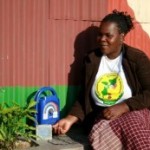 Washington — In four middle schools in the Fatick region of Senegal, nylon fabric bound to interlocking pieces of plastic piping is stirring a small revolution in educational philosophy.
Washington — In four middle schools in the Fatick region of Senegal, nylon fabric bound to interlocking pieces of plastic piping is stirring a small revolution in educational philosophy.
The materials may seem simple, but that’s the point. Combined with a solar-powered battery running a « netbook » computer connected to a small projector and infrared camera, these items are enabling teachers and students to use uncomplicated technology as a tool for 21st-century learning
With the help of a small U.S.-based company called CyberSmart , the Senegalese teachers are using the « interactive whiteboards » to spark creativity in the classroom and discussion among themselves.
The simple setup demonstrates that providing a modern education does not need to consume a great deal of energy. Rather than being concerned with building or connecting to a sophisticated power infrastructure, « off-grid » institutions in developing countries can bypass that expensive path and use low-cost, low-energy solutions.
CyberSmart came up with the idea for the whiteboards after observing how teachers were teaching, how technology was being used and whether the two were working together to advance learning. In most cases, they weren’t.
Jim Teicher, the company’s education director, said the schools did not have the means to make standard technology work in older buildings with large numbers of students . « How could they truly reach more students? » he asked.
While some of the schools, which are in poorer rural areas, have a small number of donated laptops or desktops, those computers cannot be used on a regular basis by all students, whose numbers range from several hundred to more than 1,000. In many cases, teachers have not been prepared to use the computers as teaching tools.
CyberSmart’s nylon whiteboard stands directly in front of all the students in a classroom and can be moved between classrooms several times a day. The portable setup requires no electricity and can be used in any school, including in buildings that may be in disrepair. Solar panels installed outside the school keep batteries charged and ready.
STUDENT-CENTERED APPROACH
CyberSmart is using a grant from the U.S. Agency for International Development to pilot a training program in the four Senegalese schools to help teachers create plans for using the whiteboards to teach math, science and social studies and to share those lessons with other teachers. The goal is to build a learning community among the teachers.
« We teach teachers to implement classroom practices that engage students in a learner-centered approach. Students are encouraged to lead their own instruction, finding real-world meaning in learning with the aid of our interactive whiteboard as a tool, » Teicher said. It can require a significant shift in thinking for some teachers to let students lead the process, he added.
Rather than try to modify existing technology used in the United States, CyberSmart assessed the types of technology that schools in a developing environment could support and use in sufficient scale to have the greatest impact on learning at the least possible cost.
The company focused on building a solution that fits the Senegalese schools’ infrastructure using easy-to-find lightweight components with the goal of using the whiteboards in the daily curriculum, not to teach computer skills. The computer and projector are placed behind the screen to keep them out of the way while supporting the « touch screen » interactivity.
Students walk up to the screen to touch a virtual keyboard or drag and drop icons while their classmates watch. « The equipment is as transparent and easy to use as possible so that the focus can be on learning, » Teicher said.
« For the desktop, it’s one student in front of his computer, » said Momadou Kane, principal of CEM Mbellacadiao, a middle school that has seven desktop computers for 1,044 students. « The interactive whiteboard comes into the classroom, and the students and teachers work together building knowledge. There is … initiative, student independence, also students’ creativity. »
Marieme Thioro Ndione, a teacher at CEM 2 de Gossas, which has no other computers or electronic tools, said she would like to use the whiteboard to spark discussion about the roles of women. Many girls leave the schools at an early age to get married, she said.
« We can show pictures of women working, of them as officials and ministers, » she said, « showing films and having a discussion among the girls to encourage them and show that a girl should go to school like the boys. »
This is a product of the Bureau of International Information Programs, U.S. Department of State. Web site: http://iipdigital.usembassy.gov/iipdigital-en/index.html)



